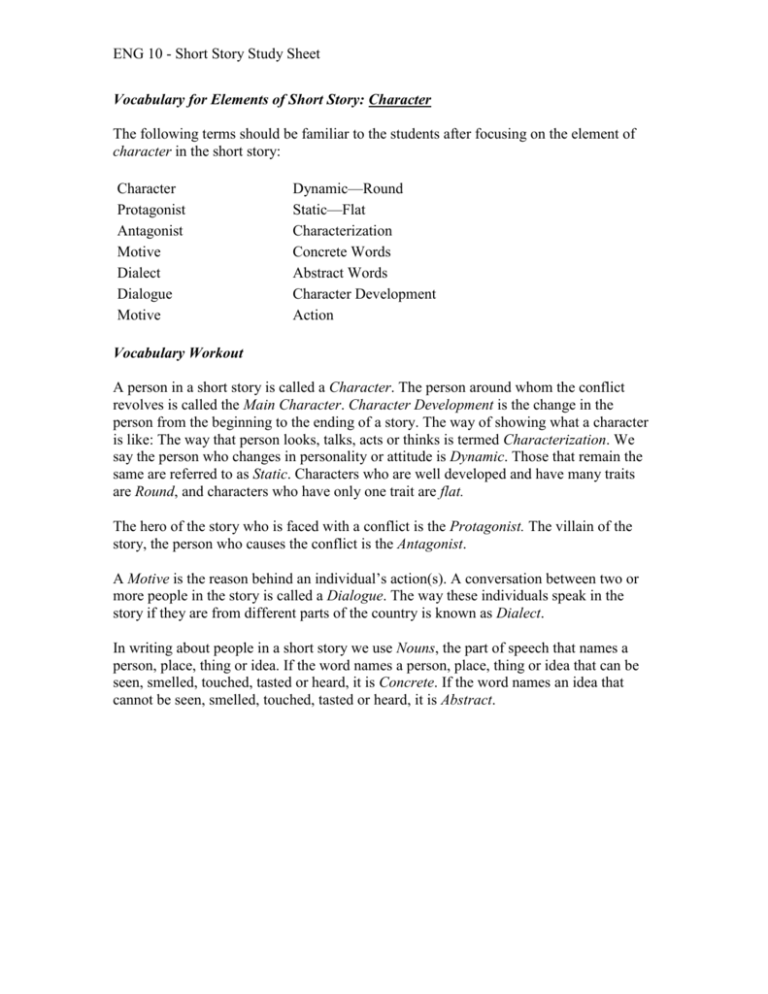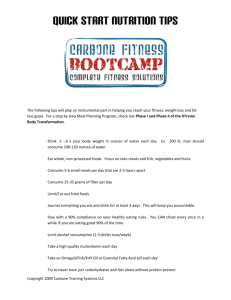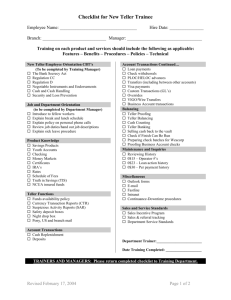Vocabulary for Elements of Short Story: Character
advertisement

ENG 10 - Short Story Study Sheet Vocabulary for Elements of Short Story: Character The following terms should be familiar to the students after focusing on the element of character in the short story: Character Protagonist Antagonist Motive Dialect Dialogue Motive Dynamic—Round Static—Flat Characterization Concrete Words Abstract Words Character Development Action Vocabulary Workout A person in a short story is called a Character. The person around whom the conflict revolves is called the Main Character. Character Development is the change in the person from the beginning to the ending of a story. The way of showing what a character is like: The way that person looks, talks, acts or thinks is termed Characterization. We say the person who changes in personality or attitude is Dynamic. Those that remain the same are referred to as Static. Characters who are well developed and have many traits are Round, and characters who have only one trait are flat. The hero of the story who is faced with a conflict is the Protagonist. The villain of the story, the person who causes the conflict is the Antagonist. A Motive is the reason behind an individual’s action(s). A conversation between two or more people in the story is called a Dialogue. The way these individuals speak in the story if they are from different parts of the country is known as Dialect. In writing about people in a short story we use Nouns, the part of speech that names a person, place, thing or idea. If the word names a person, place, thing or idea that can be seen, smelled, touched, tasted or heard, it is Concrete. If the word names an idea that cannot be seen, smelled, touched, tasted or heard, it is Abstract. ENG 10 - Short Story Study Sheet Vocabulary for Elements of Short Story: Setting The following terms should be familiar to the students after focusing on the element of setting. Setting time place Imagery Symbol Connotation Denotation Figurative Language metaphor simile personification Senses auditory (hearing) gustatory (taste) olfactory (smell) tactile (touch) visual (sight) Vocabulary Workout The setting of the short story tells the Time and Place of the action. To make a setting or background for the main character to come alive, we often use descriptive language which is not meant to be taken in its literal sense called Figurative Language. Some examples of such descriptive language are: 1. Simile: A comparison between two unlike things that uses the words like or as; for example, This bread is as hard as a rock. 2. Metaphor: A comparison between two dissimilar things that does not use the words like or as; for example, Life is a short story of conflicts and compromise. 3. Personification: That which give human traits to non-human things; for example, The waves danced on the jagged rocks. Using language that appeals to any sense or any combination of senses is called Imagery. These senses are Sight, Hearing, Taste, Touch or Smell. Sometimes using an object, person, place, or action that has a meaning in itself and stands for something larger than itself; an idea, belief, or value called Symbol helps to improve our writing of a short story. It is important that we can differentiate between the literal meaning of a word Denotation and the emotion or association that a word may arouse Connotation. ENG 10 - Short Story Study Sheet Vocabulary for Elements of Short Story: Plot The following terms should be familiar to the students after focusing on the element of plot in the short story. Conflict Solution Internal External Irony Flashback Foreshadowing Suspense Vocabulary Workout The main character is presented with a Conflict, a situation or problem which he will be called upon to resolve. Sometimes the problem lies within the main character and is said to be Internal, while other times outside forces act upon the main character, which is said to be External. There is a constant, ongoing struggle in which the main character attempts to resolve his problem; hence he seeks a Solution. Throughout this struggle a growing excitement or Suspense is felt as the Climax is approached. The author often uses certain techniques to creatively unfold the plot: Irony: An unexpected twist of events, the opposite of what was expected. Flashback: A move back in time to an earlier incident. Foreshadowing: A hint or allusion to events which will occur in the future. ENG 10 - Short Story Study Sheet Vocabulary for Elements of Short Story: Point of View The following terms should be familiar to the students after focusing on the element of point of view in the short story. Narrator First Person Omniscient Point of View Internal Story Teller Detached Observer External Story Teller Vocabulary Workout The person telling the story is called the Narrator. When the person telling the story knows all the thoughts, motives and feelings of each character, the story is being told from the Omniscient point of view. When the main character tells his own story and refers to himself as “I” the story is being told from the First Person point of view. An Internal story teller is one that takes part in the action of the story. An External story teller is one that can remove himself from the action of the story. Vocabulary for Elements of Short Story: Theme Theme Allusion Proverb Idea Maxim Vocabulary Workout The main idea or basic meaning of a literary work (short story) is called the Theme. Frequently a short story may have more than one controlling idea. Very often we can associate a wise saying or Proverb with the basic meaning of the story. Sometimes a reference in one work of literature to a person, place or event in another work of literature or in history, art or music is known as an Allusion and quite effectively reinforces the meaning of a story.



